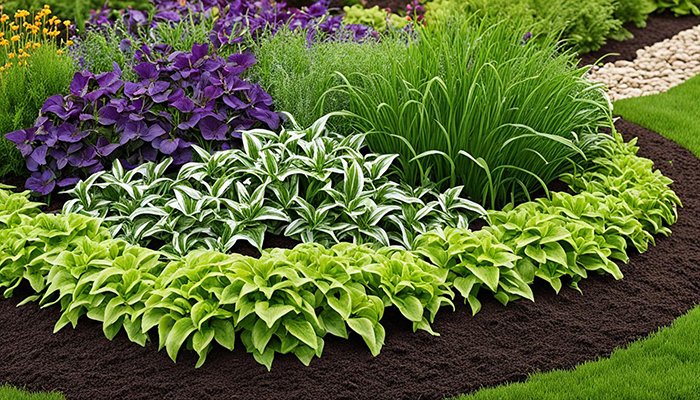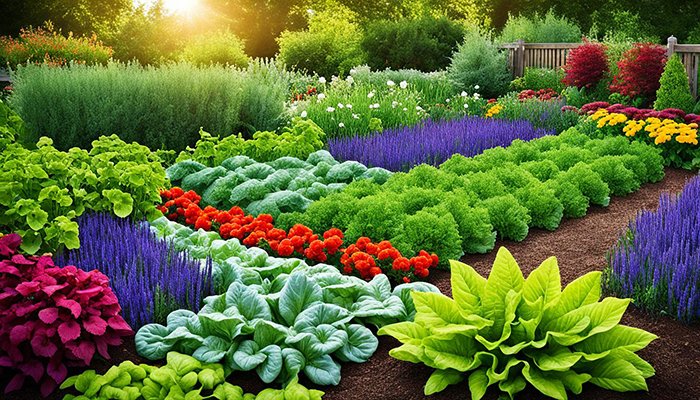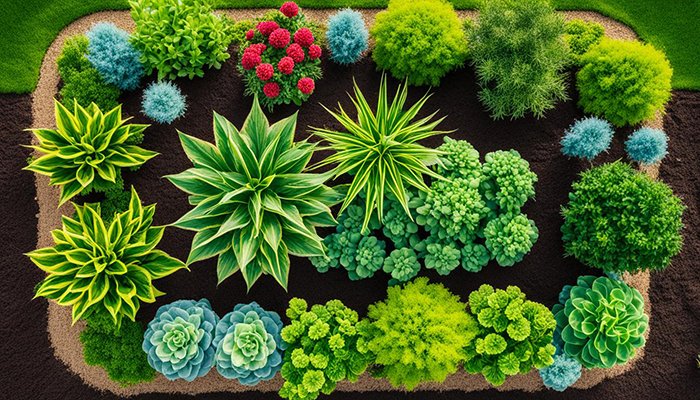Companion planting is the practice of strategically planting different crops together to improve growth, deter pests, and increase yields in a garden.
In this article, I will share some valuable companion planting tips that can help you maximize yields in your garden. From improving pollination to repelling pests and making the most of your garden space, companion planting offers numerous benefits that can lead to a thriving and bountiful garden.
Whether you’re a seasoned gardener or just starting out, these companion planting tips will provide you with the knowledge and insights you need to take your garden yields to the next level. So let’s dive in and explore the world of companion planting!
Table of Contents
What is Companion Planting?
Companion planting is an innovative gardening technique that involves cultivating different plant species together to create a symbiotic relationship. This practice is based on the observation that certain plants can complement each other in various ways, providing a range of benefits that promote overall garden health and productivity.
Companion planting can be defined as the strategic coexistence of plants that support and enhance one another’s growth. Through careful selection and placement, gardeners can harness the power of nature to optimize their crops’ potential.
By pairing compatible plants, gardeners can leverage the benefits of companion planting to tackle common gardening challenges such as pest control, nutrient availability, pollination, and maximizing limited garden space. The interactive dynamics between these paired plants create a harmonious growing environment that maximizes yields and minimizes potential problems.
So, what are some of the benefits of companion planting? Let’s explore this further.
The Benefits of Companion Planting
Companion planting offers numerous advantages by capitalizing on the unique characteristics and interactions between plant species. When done right, it can:
- Improve pest control by repelling pests or attracting beneficial insects that prey on harmful pests, reducing the need for chemical pesticides.
- Enhance soil quality through nutrient cycling, nitrogen fixation, and the accumulation of organic matter, resulting in healthier plants and increased yields.
- Increase pollination by attracting pollinators like bees and butterflies, ensuring optimal fruit set and seed production.
- Maximize garden space by intercropping compatible plants with different growth patterns, allowing for efficient use of limited space and increased variety.
- Improve flavor and aroma by pairing specific plants together, resulting in enhanced taste and scent profiles in vegetables, fruits, and herbs.
With these remarkable benefits, companion planting is an invaluable tool in the gardener’s arsenal, providing a natural and sustainable approach to nurturing a vibrant and productive garden ecosystem.
Companion Planting Chart
A companion planting chart is a handy resource that helps gardeners identify ideal plant combinations and potential plant pairings to avoid. By referring to this chart, you can make informed decisions about which plants thrive together and which ones may hinder one another’s growth.
The following table presents some examples of common companion plants and their compatibility:
| Companion Plant | Benefits |
|---|---|
| Basil | Repels pests, improves tomato flavor |
| Marigold | Deters harmful insects, attracts pollinators |
| Carrot | Attracts beneficial insects, improves soil structure |
| Cucumber | Protects corn from pests, provides shade |
Remember, the companion planting chart should serve as a helpful guide, but it’s essential to consider your specific garden’s needs and microclimates when selecting plant pairings.
Now that you understand what companion planting entails and the benefits it offers, it’s time to explore specific companion plant combinations and techniques, which will be covered in subsequent sections of this article.
Benefits of Companion Planting
Companion planting offers several benefits for gardeners. First, it provides pest control by naturally repelling insects that are harmful to certain plants. This reduces the need for pesticides and promotes a more sustainable gardening approach.
Second, certain plant combinations can improve soil quality. Plants like legumes, such as beans and peas, have the ability to fix nitrogen in the soil, enriching it with this essential nutrient. Additionally, certain plants can add organic matter when their leaves or stems decompose, further enhancing soil fertility. These improvements in soil structure can lead to healthier plants with stronger root systems.
Third, companion planting can attract more pollinators like bees and butterflies to your garden, increasing pollination and improving fruit set. Flowers, such as marigolds and sunflowers, are particularly effective at attracting these beneficial insects, resulting in better yields and more abundant harvests.
Fourth, companion planting can help you maximize space in your garden. By combining plants with different growth habits, such as tall plants with shallow-rooted ones, you can make efficient use of vertical and horizontal spaces. This allows you to grow a greater variety of crops in limited areas.
Finally, certain companion plant combinations can enhance the flavor and quality of certain vegetables and herbs. For example, planting dill near tomatoes can improve the taste of the tomatoes, while growing basil near bell peppers can enhance their flavor. These natural pairings can transform ordinary dishes into culinary delights.
Overall, companion planting offers a multitude of benefits, from pest control and improved soil quality to increased pollination and maximizing space. Additionally, the enhanced flavor of the harvest is an added bonus. By understanding the principles of companion planting and selecting the right plant combinations, gardeners can create a harmonious and productive garden ecosystem.

Common Companion Plant Combinations
When it comes to companion planting, choosing the right plant combinations can make a significant difference in the health and productivity of your garden. Whether you’re a beginner or an experienced gardener, the companion planting chart is an invaluable resource to help you determine which plants work well together and which ones should be kept separate.
For example, tomatoes and basil are considered good companions because basil can help repel pests that commonly attack tomato plants. This combination not only enhances the flavor of tomatoes but also helps protect them naturally. On the other hand, tomatoes and corn are not recommended to be planted together as they are considered bad companions. Corn can attract pests that can harm tomato plants and decrease their overall productivity.
The companion planting chart provides a comprehensive list of plant combinations, categorizing them into good companions and bad companions. It serves as a handy reference when planning your garden and ensures that you select compatible plants that can thrive together.
“The companion planting chart has been my go-to guide for years. It’s great to have a resource that helps me make informed decisions about which plants to pair together. It’s saved me from potential crop failures and given my garden a boost in productivity!”- Jane, avid gardener
By utilizing the companion planting chart, you can create harmonious plant communities in your garden, promoting healthier growth and maximizing yields. So, before you start planting, make sure to consult the chart and choose your plant combinations wisely!
| Good Companions | Bad Companions |
|---|---|
| Tomatoes and basil | Tomatoes and corn |
| Lettuce and radishes | Lettuce and cabbage |
| Carrots and onions | Garlic and peas |
| Beans and potatoes | Beans and onions |

The Three Sisters Companion Planting Technique
The Three Sisters companion planting technique is an ancient Indigenous tradition that involves planting corn, beans, and squash together. These three crops form a harmonious symbiotic relationship, with each plant providing unique benefits to the others.
“The Three Sisters – corn, beans, and squash – are inseparable sisters who only grow and thrive when they are together.”
Corn: Providing Structure and Support
Corn plays a crucial role in the Three Sisters planting technique. Its tall stalks provide a sturdy, vertical structure for the beans to climb. As the beans grow, they wrap themselves around the corn stalks, creating a natural trellis system that keeps the beans off the ground and promotes optimal growth.
Beans: Nitrogen-Fixing Powerhouse
Beans are nitrogen-fixing plants, meaning they have the ability to convert atmospheric nitrogen into a usable form for themselves and neighboring plants. By fixing nitrogen in the soil, beans contribute to the overall fertility and health of the garden. They release nitrogen as they grow, which benefits not only themselves but also the corn and squash growing nearby.
Squash: Ground Cover and Pest Control
Squash serves as a valuable ground cover in the Three Sisters trio. Its trailing vines create a dense blanket over the soil surface, suppressing weed growth and minimizing moisture evaporation. The broad leaves of squash plants also provide shade, helping to keep the soil cool and moist for all three crops. Additionally, squash acts as a natural pest deterrent, discouraging pests from attacking the corn and beans.
A Perfect Union
The Three Sisters companion planting technique is more than just a clever combination of plants; it is a mutually beneficial relationship that maximizes space, enhances soil fertility, and increases overall crop yields. By working together, corn, beans, and squash create an ecosystem where each plant thrives, supporting and nourishing one another.
Versatile Companion Plants
In addition to specific companion planting techniques, incorporating versatile companion plants into your garden can provide various benefits. These plants act as natural insect repellents, pollinator magnets, and flavorful companions, creating a diverse and thriving ecosystem.
One example of a versatile companion plant is nasturtiums. These vibrant flowers not only add beauty to your garden but also act as natural insect repellents, helping to deter pests and protect your crops. Similarly, marigolds are known for their pest-repellent properties and can be planted throughout your garden to prevent insect damage.
Another essential companion plant is borage. This flowering herb acts as a pollinator magnet, attracting beneficial bees and butterflies to your garden. The presence of these pollinators improves the overall pollination process and enhances the yield of your plants. Similarly, calendula, also known as marigold, has bright and colorful flowers that attract pollinators and add a touch of beauty to your garden.
When it comes to enhancing the flavor of neighboring vegetables and herbs, certain companion plants shine. Mint, with its refreshing aroma, complements a wide range of culinary herbs and adds a burst of freshness to your dishes. Basil, another flavorful companion, brings out the best in tomatoes and is often planted alongside them to improve the flavor of both plants. Additionally, thyme adds a delightful earthy flavor to a variety of companion plants and can be used to enhance the taste of your garden produce.
“Versatile companion plants are like multitaskers in the garden, offering a range of benefits from pest control to flavor enhancement.”
By incorporating these versatile companion plants into your garden, you can create a harmonious environment that promotes healthy plant growth, natural insect repellents, increased pollination, and enhanced flavor. These plants are easy to grow, visually appealing, and provide numerous benefits that contribute to the overall success of your garden.
Companion Planting Examples
To help you visualize the potential combinations of versatile companion plants, here is a table showcasing some common examples:
| Companion Plant | Benefit |
|---|---|
| Nasturtium | Acts as a natural insect repellent to deter pests |
| Marigold | Repels insects and adds vibrant color to the garden |
| Borage | Attracts pollinators like bees and butterflies |
| Calendula | Provides additional pollination and bright flowers |
| Mint | Enhances the flavor of adjacent vegetables and herbs |
| Basil | Improves the flavor of tomatoes and other plants |
| Thyme | Adds an earthy flavor to companion plants |
As you plan your garden, consider incorporating these versatile companion plants to create a thriving and productive space. Their natural pest control properties, attraction to pollinators, and ability to enhance flavor make them valuable additions to any garden.
Maximizing Space and Yield
When it comes to gardening, space is a precious resource. Maximizing the yield of your garden requires careful planning and strategic planting. This is where companion planting can be a game-changer. By interplanting root crops like radishes, carrots, and beets, you can efficiently use your garden space while allowing each crop to thrive without competing for resources. This technique is known as interplanting, and it maximizes the yield by utilizing the vertical space and optimizing the use of nutrients and sunlight.
Interplanting root crops offers several benefits. Firstly, it prevents soil erosion and improves the structure of the soil by creating a natural barrier against wind and water runoff. Secondly, these crops have complementary root systems that help prevent soil nutrient depletion. For example, radishes have long taproots that break up compacted soil, creating channels for water and nutrients to penetrate. Meanwhile, carrots and beets have dense fibrous roots that enhance soil aeration and nutrient absorption. Together, these root crops work harmoniously to improve soil health and maximize the available resources.
As you interplant root crops, consider filling in the spaces between them with complementary fill-in plants. These plants, such as dill, lettuce, beans, and cucumbers, act as efficient space fillers that not only enhance biodiversity but also maximize productivity. The fill-in plants don’t overshadow the root crops, but rather take advantage of the available sunlight and nutrients, creating a thriving ecosystem within your garden.
An important consideration when interplanting and selecting fill-in plants is their compatibility. Choose plants that have similar growing requirements, such as sun exposure, water needs, and soil preferences. This will ensure that all plants in your garden can coexist harmoniously and support each other’s growth and yield. By carefully planning your interplanting and fill-in plant combinations, you can create a vibrant and productive garden that utilizes space effectively and yields bountiful harvests.
Integrating companion planting techniques like interplanting and using complementary fill-in plants is an effective way to maximize the space and yield of your garden. By leveraging the symbiotic relationships between different plant species, you can create a thriving ecosystem that optimizes resources and promotes the healthy growth of your plants. Embrace the power of companion planting and unlock the true potential of your garden.
Conclusion
Companion planting is a valuable technique that can help you maximize yields and create a thriving garden. By understanding the principles of companion planting and using the right plant combinations, you can promote pest control, improve soil quality, attract pollinators, and maximize space in your garden.
Whether you’re practicing companion planting in a square foot garden or a traditional garden, this method can lead to healthy and abundant harvests. By incorporating companion planting strategies into your garden planning, you can unlock the full potential of your plants and create a harmonious and productive garden ecosystem.
So, as you embark on your gardening journey, consider the benefits of companion planting. From repelling pests to attracting pollinators, companion planting offers a multitude of advantages. By harnessing the power of plant relationships, you can create a truly vibrant and bountiful garden that will delight both your eyes and your taste buds. Happy gardening!
FAQ > Companion Planting
What is companion planting?
Companion planting is a gardening technique that involves growing different plants together to improve their growth, health, and yield. It can help maximize the productivity of your garden by enhancing pollination, repelling pests, improving soil quality, and maximizing space.
What are the benefits of companion planting?
Companion planting offers several benefits for gardeners. It can help with pest control by repelling insects, improve soil quality, attract more pollinators, maximize garden space, and enhance the flavor and quality of certain vegetables and herbs.
Are there specific plant combinations that work well together?
Yes, there are many different companion plant combinations that can be used in the garden. The companion planting chart provides a helpful guide to determine which plants are good companions and which are not.
What is the Three Sisters companion planting technique?
The Three Sisters companion planting technique involves planting corn, beans, and squash together. This trio of crops forms a symbiotic relationship where each plant provides unique benefits to the others.
Are there versatile companion plants that can be used throughout the garden?
Yes, there are versatile companion plants that can provide various benefits. Nasturtiums and marigolds can help deter pests, borage and calendula attract pollinators, and mint, basil, and thyme enhance the taste of adjacent vegetables and herbs.
How can companion planting help maximize space and yield?
Companion planting can help maximize space and yield by interplanting root crops, such as radishes, carrots, and beets, and filling in the spaces between plants with complementary fill-in plants, like dill, lettuce, beans, and cucumbers.
You might also be interested in:
Gardening Advice : Click Here


